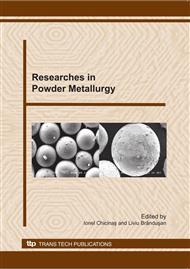p.3
p.12
p.17
p.23
p.31
p.39
p.47
p.55
Gigacycle Fatigue Response of PM versus Ingot Metallurgy Tool Steels
Abstract:
In this work, the gigacycle fatigue response of several tool steel grades has been studied using an ultrasonic resonance testing device. It showed that both with ingot metallurgy (IM) and powder metallurgy (PM) tool steels, a true fatigue limit does not exist up to 10E10 cycles. PM steels resulted in significantly higher endurance strength levels than IM grades. However, there was virtually no effect of the composition and hardness of the materials, both for PM and IM grades cold work tool steels and high speed steels exhibiting virtually the same S-N curves. In the IM tool steel grades, crack initiation started at large primary carbides or carbide clusters, while in the PM grades, nonmetallic inclusions were the critical sites. In any case it is very important to avoid introducing residual stresses into the specimen surfaces during preparation, which would markedly shift the endurance strength levels.
Info:
Periodical:
Pages:
23-30
Citation:
Online since:
January 2011
Keywords:
Price:
Сopyright:
© 2011 Trans Tech Publications Ltd. All Rights Reserved
Share:
Citation:


